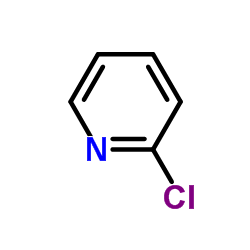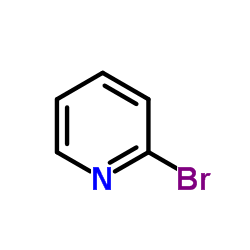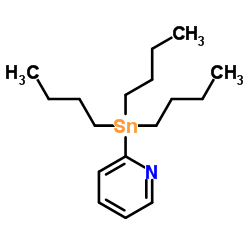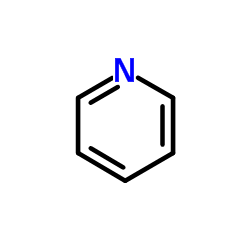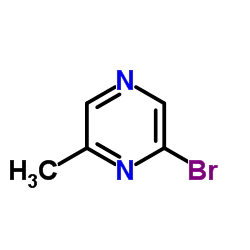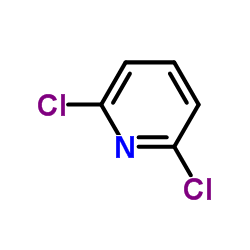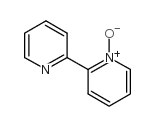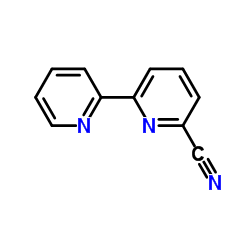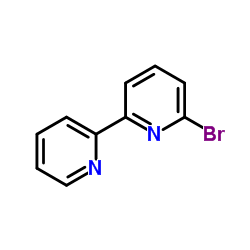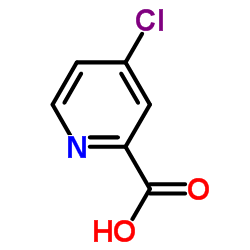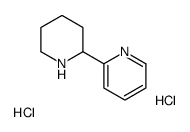366-18-7
| Name | 2,2'-bipyridine |
|---|---|
| Synonyms |
bipyridine
2-(2-pyridyl)pyridine α,α'-dipyridine EINECS 206-674-4 2,2’-Bipyridyl dipyridyl 2,2'-Bipyridin 2,2-BIPYRIDINE 2-pyridin-2-ylpyridine 2,2′-bipyridine 2,2′-bipyridyl [2,2]Bipyridinyl α,α'-bipyridine 2,2′ bipyridine 2,2’-bipyridine 2,2'-BIPYRIDINE-3,3'-DIOL 2,2'-Bipyridyl 2,2'-Bipyridine 2,2'-Dipyridyl bipyridyl bpy 2,2‘-Dipyridyl 2,2`-Bipyridyl Dipyridyl, 2,2' MFCD00006212 2,2′-bipyridinyl 2,2'-dipyridine 2,2-Dipyridyl α,α'-dipyridyl bipy α,α'-Bipyridyl |
| Description | 2,2'-Bipyridine is the unique molecular scaffold of the bioactive natural products represented by caerulomycins (CAEs) and collismycins (COLs). 2,2'-Bipyridine is extensively used as the core structure of many chelating ligands by acting as a bridge in the arrangement of the catalytic center[1]. |
|---|---|
| Related Catalog | |
| References |
| Density | 1.1±0.1 g/cm3 |
|---|---|
| Boiling Point | 272.5±0.0 °C at 760 mmHg |
| Melting Point | 70-73 °C(lit.) |
| Molecular Formula | C10H8N2 |
| Molecular Weight | 156.184 |
| Flash Point | 107.2±12.0 °C |
| Exact Mass | 156.068741 |
| PSA | 25.78000 |
| LogP | 1.28 |
| Vapour Pressure | 0.0±0.5 mmHg at 25°C |
| Index of Refraction | 1.581 |
| Stability | Stable. Incompatible with strong oxidizing agents, most common metals. May be light sensitive. |
| Water Solubility | 5.5 g/L 22 ºC |
CHEMICAL IDENTIFICATION
HEALTH HAZARD DATAACUTE TOXICITY DATA
MUTATION DATA
|
| Symbol |

GHS06 |
|---|---|
| Signal Word | Danger |
| Hazard Statements | H301 + H311 |
| Precautionary Statements | P280-P301 + P310-P312 |
| Personal Protective Equipment | Eyeshields;Faceshields;Gloves;type P2 (EN 143) respirator cartridges |
| Hazard Codes | T:Toxic |
| Risk Phrases | R25 |
| Safety Phrases | S36/37-S45-S36/37/39-S26 |
| RIDADR | UN 2811 6.1/PG 3 |
| WGK Germany | 3 |
| RTECS | DW1750000 |
| Packaging Group | III |
| Hazard Class | 6.1 |
| HS Code | 29333999 |
| Precursor 10 | |
|---|---|
| DownStream 10 | |
| HS Code | 2933399090 |
|---|---|
| Summary | 2933399090. other compounds containing an unfused pyridine ring (whether or not hydrogenated) in the structure. VAT:17.0%. Tax rebate rate:13.0%. . MFN tariff:6.5%. General tariff:20.0% |



